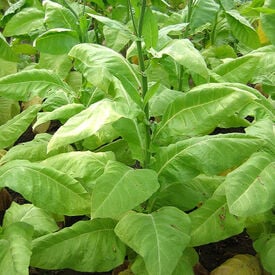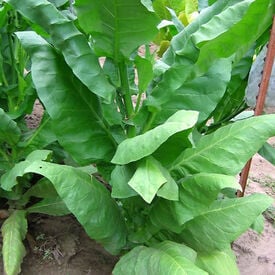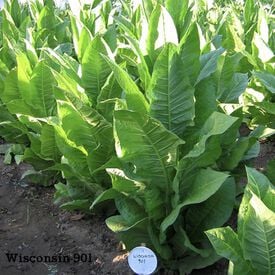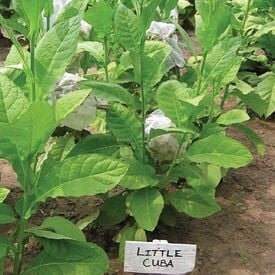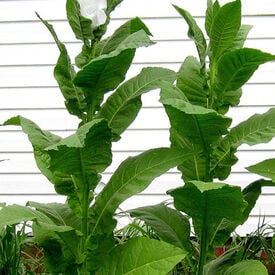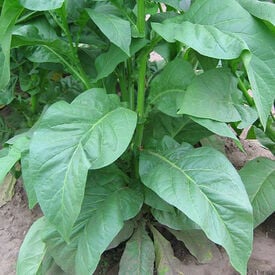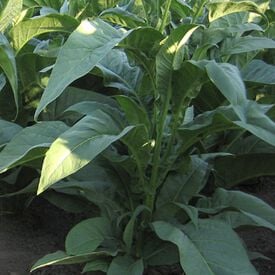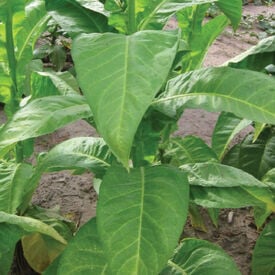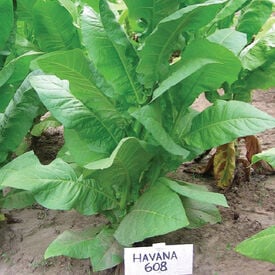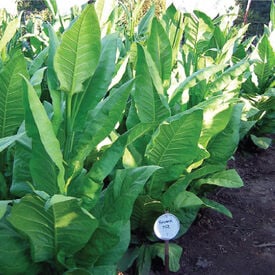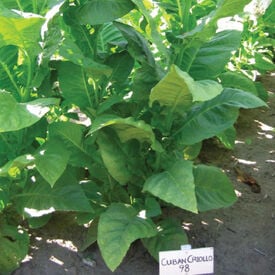L'Assomption 201 is a cigar filler variety developed in Canada, at the L'Assomption Experimental Station during the 1930s. It is useful for as a cigar wrapper, binder and filler. The plant reaches a height of 4 1/2 to 5' at the crows foot and produces an average of 18 leaves. It reaches maturity in 50-55 days. It can be primed or stalk-cut or stalk-cured and air-cures easily to a deep, medium brown.
Comstock Spanish is an heirloom variety classified as a cigar binder but also makes an excellent wrapper. It was developed in Wisconsin in the late 1800's after the civil war. It is believed it was developed from Wisconsin Havana Seed but was called a "spanish" variety, named after a pioneer grower. It grows to a height of 4 1/2' with leaves 12"-14" wide and 24"-26" long. Maturity is in 45-50 days. Plants average 20-22 harvestable leaves which are strong and have good elasticity when cured. The leaves droop downward with down turned edges when ripe.
Most commonly used as a cigar binder but may be used as a filler or pipe tobacco blend or in cigarettes. It produces large leaves, has a tight upright columnar form.
Little Cuba is a small bush like plant that matures very early. Blooms first appear in 28 days. Clipping the blooms will encourage more growth from below and 3-4 new branches will grow up to 3'-4' high. This will increase the yield of this small Cuban type tobacco and a second bloom will appear at about 60 days. The leaves are between 7"-10" in width and 10"-14" long. Leaves appearing before the first bloom will ripen first becoming a mottled yellow with yellow edges.
Lancaster Seed Leaf, grown extensively around Lancaster, Pennsylvania, and is classified as a cigar filler. But its large leaves make it a good binder or wrapper as well. Cures to a deep brown color. The upper leaf can produce excellent "Pennsylvania maduro," for pipe blending. Yields an average of 3 ounces of cured leaf per plant. Days to Maturity: 55-60, Plant Height: 50-60", Leaf Count: 17-19.
Walkers Broad Leaf is an heirloom cigar variety dating back to the 1880's, said to have originally been developed from the Maryland Broad Leaf. It grows to 6' in height and matures in 55-60 days. The leaves are from 12" to 16" wide and 20" to 24" in length, turning a light green and mottled when ripe. It can be used as a wrapper, binder or filler.
Pennsylvania Red is a rich full flavored tobacco and a long time favorite of cigar makers as a filler or binder. It grows to 5' in height and has very large long deep colored leaves reaching 3' in length. A very good producer with leaves cure to a deep reddish brown.
Olor produces a leaf of very good quality. The plant grows to 6' with little to no suckering. The leaves are light green, sharply pointed and average 14" wide and 20" to 22" long, becoming yellow as they ripen. It reaches maturity and begins blooming in approximately 60 days. * "The Dominican Republic is the leading country worldwide when it comes to tobacco cultivation. Its cigars are the most popular in the United States, one of the most tobacco-loving countries in the world. They have recently been able to overtake their direct rival, the Havana cigar, as the world’s most popular tobacco According to the International Tobacco Growers’ Association, they have already conquered 60% of the North American tobacco market. At the same time, the whole of Europe as well as most African and Asian countries, including China, are faithful clients of the Dominican tobacco market."
La Palma Havana tobacco, hailing from the renowned tobacco-growing region of La Palma in Cuba, is esteemed for its rich history and exceptional quality. This variety, deeply rooted in the traditions of Cuban tobacco cultivation, is celebrated for its exquisite flavor and aroma, reminiscent of the finest Cuban cigars. La Palma Havana tobacco is characterized by its medium to dark brown leaves, carefully cultivated and expertly cured to preserve its unique characteristics. Its flavor profile is marked by a harmonious blend of earthy richness, hints of sweetness, and a subtle spiciness that adds depth and complexity to the smoking experience. The aroma of La Palma Havana tobacco is equally captivating, exuding notes of cedar, leather, and warm spices that evoke the essence of Cuba's cigar-making heritage. Whether used as a standalone leaf or blended with other tobaccos, La Palma Havana tobacco embodies the craftsmanship, tradition, and unparalleled quality that define Cuban cigar culture. Its timeless allure and exceptional taste continue to captivate tobacco enthusiasts around the world, offering a taste of the storied legacy of Cuban tobacco craftsmanship.
Red Rose tobacco is a distinguished variety known for its aromatic qualities and rich, satisfying flavor. With leaves ranging from light to medium brown, this tobacco cultivar is cherished by enthusiasts for its versatility and pleasant smoking experience. Upon ignition, Red Rose tobacco emits a delightful aroma that hints at its warm and earthy undertones, complemented by subtle sweet and spicy notes. The smoke produced by Red Rose tobacco is smooth and mellow, making it a popular choice for both pipe and cigarette blends. Its balanced flavor profile, coupled with its smooth burning characteristics, ensures a pleasurable smoking experience with every puff. Whether enjoyed alone or blended with other tobaccos, Red Rose tobacco stands as a testament to the artistry and craftsmanship of tobacco cultivation, offering a timeless indulgence for discerning smokers.
Havana 501 tobacco, a revered member of the tobacco family, is celebrated for its rich heritage, distinctive flavor, and versatility. Originating from the fertile fields of Cuba, this renowned variety is renowned for its connection to the world-famous Cuban cigar tradition. Havana 501 boasts medium to dark brown leaves, carefully cultivated and cured to perfection. Its flavor profile is characterized by a harmonious blend of earthy richness, subtle sweetness, and spicy undertones, creating a complex and satisfying smoking experience. The aroma of Havana 501 is equally captivating, with hints of cedar, leather, and warm spices that evoke images of old Havana cigar lounges. Whether enjoyed on its own in a premium cigar or blended with other tobaccos to enhance complexity, Havana 501 exemplifies the craftsmanship and tradition of Cuban tobacco cultivation. Its timeless appeal and exceptional quality have earned it a place of honor among tobacco connoisseurs worldwide, embodying the spirit of Havana's storied cigar-making heritage.
Havana 608 is a cigar filler or binder tobacco. It grows to 6' closely spaced leaves and matures in about 65 days. The leaves are a very bright green and upturned with slightly down turned tips. It holds up well during inclement weather and the pyramidal shape gives it good wind resistance. The leaves turn a light yellow green with yellowing at the edges when ripe. Plants average 20 harvestable leaves per plant, and are 14"-16" in width and 20" long. Air cures to a medium brown.
Havana 142 is classified as a cigar binder but is often used in making chew. Many growers find it makes an excellent cigarette tobacco as well. A columnar plant which grows to a height of 4 feet, it matures in only 55 days. A good choice for areas with short growing seasons. Air cures to a light brown.
Cuban Criollo 98 is one of the most valued strains for Cuban cigars. It originated from a crossing between the varieties ' Havana 92' and `Habana P.R'. Cultivated in the sun it produces from 14 to 16 useful leaves per plant and makes an excellent binder. It reaches an average height of 6 feet. Leaves average 24 inches in length and 12 inches wide. It is resistant to the Blue Mold, the Blackish Paw and the Tobacco Mosaic Virus and moderately resistant to the Environmental Necrosis.
Habano 2000 is derived from a crossing between the variety Corojo and a Cuban dark tobacco, the Habano 2.1.1, from which is derived its resistance to the Gray Mold. Grown in direct sun. it reaches an average height of 6 feet with 14-16 leaves per plant. In very rich soils it can develop up to 18 leaves per plant. Sun grown plants are often used as a binder or filler. Grown under a shade cloths, Habano 2000 makes an excellent wrapper.
